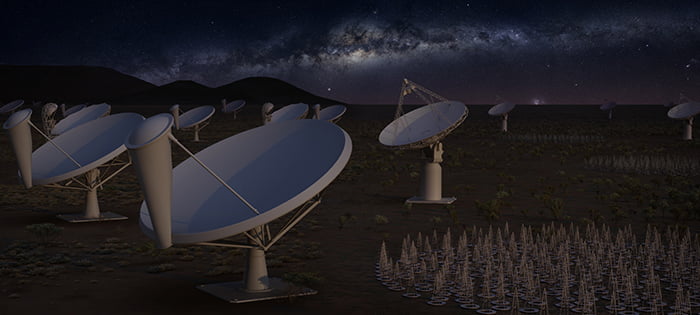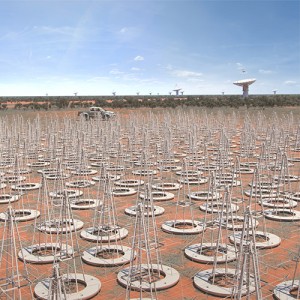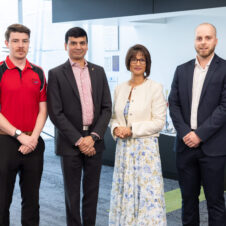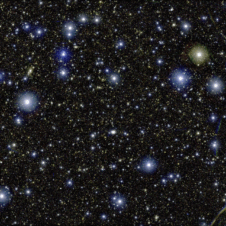
Artist impression representing the first phase of the Square Kilometre Array at night, with its two instruments SKA1 LOW (in Australia, on the right) and SKA1 MID (in South Africa, on the left). SKA1 LOW will be made of some 130,000 dipole antennas and SKA1 MID of some 200 dishes, including 64 MeerKAT dishes. Also pictured on the images are the ASKAP dishes in Australia. Credit: SKAO
“I was impressed by the strong support from the Board and the momentum to take the project forward”, said Professor Philip Diamond, Director General of the SKA Organisation. “The SKA will fundamentally change our understanding of the Universe. We are talking about a facility that will be many times better than anything else out there.”
Presently in its design phase, the international project, currently consisting of 11 nations, has been engaged over the last 20 months in a rigorous and extremely challenging science-driven, engineering process with teams from around the world working to refine the design of SKA1.
The SKA instruments will be located in two countries – South Africa and Australia. In the first phase of the project, South Africa will host about 200 parabolic antennas or dishes – similar to, but much larger than a standard domestic satellite dish – and Australia more than 100,000 ‘dipole’ antennas, which resemble domestic TV aerials.
“Thanks to these two complementary instruments, we will address a broad range of exciting science, such as observing pulsars and black holes to detect the gravitational waves predicted by Einstein, testing gravity, and looking for signatures of life in the galaxy”, said Professor Robert Braun, Science Director of the SKA Organisation. “We will also observe one of the last unexplored periods in the history of our Universe – the epoch of re-ionisation – looking back to the first billion years of the Universe at a time when the first stars and galaxies are forming.”
The Australian SKA Pathfinder (ASKAP) telescope, a precursor telescope already operating as a first-class instrument in its own right in Western Australia, will continue to provide world-leading survey capability which will complement the overall SKA programme. The SKA will incorporate a programme for the development of next-generation Phased Array Feeds (PAFs), a technology that greatly enhances the field of view of radio telescopes, allowing for observations of a larger portion of the sky in any given time. In South Africa, the MeerKAT telescope, another precursor to the SKA, will be integrated into the dish array.
“This will build on South Africa’s considerable investment in science and in particular radio astronomy, it’s something we can rightly be very proud of”, said Dr Phil Mjwara, Director General of the South African Department of Science and Technology. “Being involved in this exciting global science project spanning two continents alongside our Australian colleagues and colleagues from around the world is great for the country and for the African continent.”
“The Australian astronomical community are delighted to be working with their colleagues from around the world in one of the most thrilling science endeavours of the 21st century”, said Professor Brian Boyle, Australia’s SKA Director. “This outcome recognises the confidence the global community has placed in the world-class observatory we have built in Western Australia and the leading-edge radio-astronomy technology Australia has developed for the pathfinder telescopes located there.”
“The next step is to work with the SKA partner countries to develop an international Organisation before the start of the construction in 2018”, said Professor John Womersley, Chair of the SKA Board of Directors. “This incredible telescope has a design, it is within budget, construction is around the corner, it will drive technology development in the era of Big Data, and it is going to deliver Nobel prize-winning science. In short, it will have an invaluable impact on society like very few enterprises before it.”
Notes for editors:
The Square Kilometre Array (SKA) project is an international effort to build the world’s largest radio telescope, led by the SKA Organisation from Jodrell Bank Observatory in the UK. The SKA will conduct transformational science to improve our understanding of the Universe and the laws of fundamental physics, monitoring the sky in unprecedented detail and mapping it hundreds of times faster than any current facility.
The SKA is not a single telescope, but a collection of telescopes or instruments, called an array, to be spread over long distances. The SKA is to be constructed in two phases: Phase 1 (called SKA1) in South Africa and Australia; Phase 2 (called SKA2) expanding into other African countries, with the Australian component also being expanded.
Already supported by 11 member countries – Australia, Canada, China, Germany, India, Italy, New Zealand, South Africa, Sweden, The Netherlands and the United Kingdom – the Organisation has brought together some of world’s finest scientists, engineers and policy makers and more than 100 companies and research institutions across 20 countries in the design and development of the telescope. Construction of the SKA is set to start in 2018, with early science observations in 2020.
Contact information:
SKA Organisation:
William Garnier
Communications and Outreach Manager
w.garnier@skatelescope.org
+44 7814908932
SKA Australia:
Jerry Skinner
Manager, Program Planning and Stakeholder Management
jerry.skinner@industry.gov.au
+61-2-6213 6298
SKA South Africa:
Lorenzo Raynard
Science Communication Manager
lraynard@ska.ac.za
+27 71 4540658
More information:
Frequently Asked Questions (FAQ) section about the SKA from the SKA Office.


